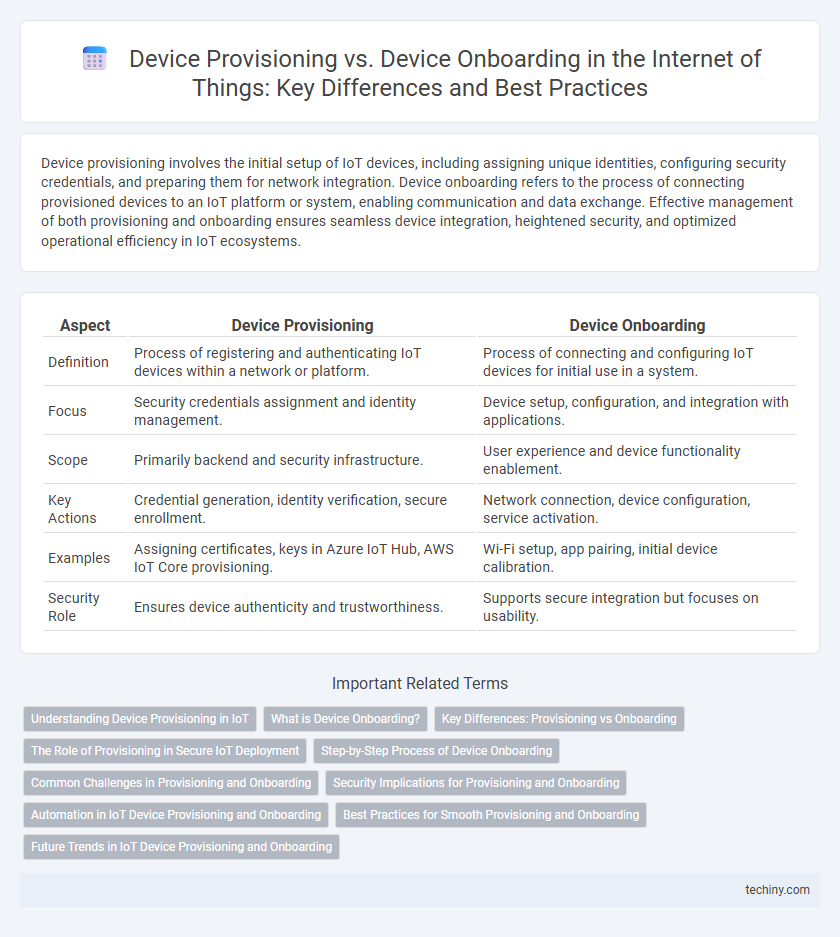Device provisioning involves the initial setup of IoT devices, including assigning unique identities, configuring security credentials, and preparing them for network integration. Device onboarding refers to the process of connecting provisioned devices to an IoT platform or system, enabling communication and data exchange. Effective management of both provisioning and onboarding ensures seamless device integration, heightened security, and optimized operational efficiency in IoT ecosystems.
Table of Comparison
| Aspect | Device Provisioning | Device Onboarding |
|---|---|---|
| Definition | Process of registering and authenticating IoT devices within a network or platform. | Process of connecting and configuring IoT devices for initial use in a system. |
| Focus | Security credentials assignment and identity management. | Device setup, configuration, and integration with applications. |
| Scope | Primarily backend and security infrastructure. | User experience and device functionality enablement. |
| Key Actions | Credential generation, identity verification, secure enrollment. | Network connection, device configuration, service activation. |
| Examples | Assigning certificates, keys in Azure IoT Hub, AWS IoT Core provisioning. | Wi-Fi setup, app pairing, initial device calibration. |
| Security Role | Ensures device authenticity and trustworthiness. | Supports secure integration but focuses on usability. |
Understanding Device Provisioning in IoT
Device provisioning in IoT involves securely registering and configuring devices with necessary credentials, network settings, and access controls to enable seamless communication within the ecosystem. This process ensures that each device is authenticated and authorized before it becomes operational, mitigating security risks and preventing unauthorized access. Effective device provisioning streamlines large-scale deployments by automating configuration tasks and maintaining consistent device management protocols.
What is Device Onboarding?
Device onboarding in the Internet of Things (IoT) refers to the process of securely connecting and integrating a new IoT device into a network, enabling it to communicate and function within the system. This involves authenticating the device, configuring its network settings, and establishing trust between the device and the IoT platform. Effective device onboarding ensures seamless device management, secure data exchange, and reliable operation within IoT ecosystems.
Key Differences: Provisioning vs Onboarding
Device provisioning in the Internet of Things (IoT) refers to the initial process of configuring a device with essential credentials, security keys, and network settings before it connects to the IoT ecosystem. Device onboarding occurs after provisioning and involves integrating the device into the network, establishing trust relationships, and enabling communication with IoT platforms or applications. Key differences include provisioning focusing on setup and security preparation, while onboarding centers on activating and managing the device within the operational environment.
The Role of Provisioning in Secure IoT Deployment
Device provisioning establishes the foundational security framework by configuring device identities, credentials, and access policies before network integration, ensuring trustworthiness in IoT ecosystems. This process enables scalable, automated, and secure deployment by enrolling devices with unique cryptographic keys and certificates. Effective provisioning mitigates risks such as unauthorized access, data breaches, and device spoofing, which are critical for maintaining integrity and confidentiality in IoT operations.
Step-by-Step Process of Device Onboarding
Device onboarding in the Internet of Things involves a structured step-by-step process starting with device identification and authentication, followed by secure connectivity establishment, configuration of device settings, and integration into the network management system. Each step ensures that IoT devices comply with security protocols and operational standards, facilitating seamless communication and management. Effective device onboarding enables scalable network deployment and enhances device lifecycle management within IoT ecosystems.
Common Challenges in Provisioning and Onboarding
Device provisioning and onboarding in the Internet of Things face common challenges such as secure identity management, scalability in handling large device volumes, and interoperability across different platforms and protocols. Ensuring robust authentication mechanisms and seamless integration without manual intervention are critical for reducing deployment time and enhancing security. Managing firmware updates and maintaining consistent device configuration throughout the lifecycle further complicate effective provisioning and onboarding processes.
Security Implications for Provisioning and Onboarding
Device provisioning involves securely generating and storing cryptographic keys and credentials to authenticate IoT devices within a network, ensuring robust identity validation before communication begins. Device onboarding extends this process by integrating the authenticated device into the network's operational environment, maintaining secure communication channels and enforcing access controls to prevent unauthorized access and data breaches. Effective security measures during provisioning and onboarding are critical to mitigate risks such as device spoofing, man-in-the-middle attacks, and unauthorized device manipulation in IoT ecosystems.
Automation in IoT Device Provisioning and Onboarding
Automation in IoT device provisioning streamlines the configuration and authentication processes, enabling devices to securely connect to networks without manual intervention. Device onboarding automation ensures seamless integration by automatically registering devices, applying security policies, and configuring necessary services in real-time. This reduces errors, accelerates deployment timelines, and enhances scalability for large-scale IoT ecosystems.
Best Practices for Smooth Provisioning and Onboarding
Device provisioning involves securely registering and configuring IoT devices before deployment, while device onboarding refers to integrating these devices into the operational network for real-time communication. Best practices for smooth provisioning and onboarding include automating certificate management, enforcing strict identity verification, and utilizing secure boot processes to prevent unauthorized access. Leveraging scalable cloud-based platforms and standardized protocols like MQTT or CoAP enhances interoperability and accelerates device integration within IoT ecosystems.
Future Trends in IoT Device Provisioning and Onboarding
Future trends in IoT device provisioning and onboarding emphasize automated, scalable processes leveraging AI and edge computing for enhanced security and reduced latency. Zero-touch provisioning protocols are becoming standard, enabling seamless and secure device integration into networks without manual intervention. Advances in blockchain technology promise decentralized identity management, improving trust and interoperability among heterogeneous IoT ecosystems.
Device provisioning vs Device onboarding Infographic

 techiny.com
techiny.com